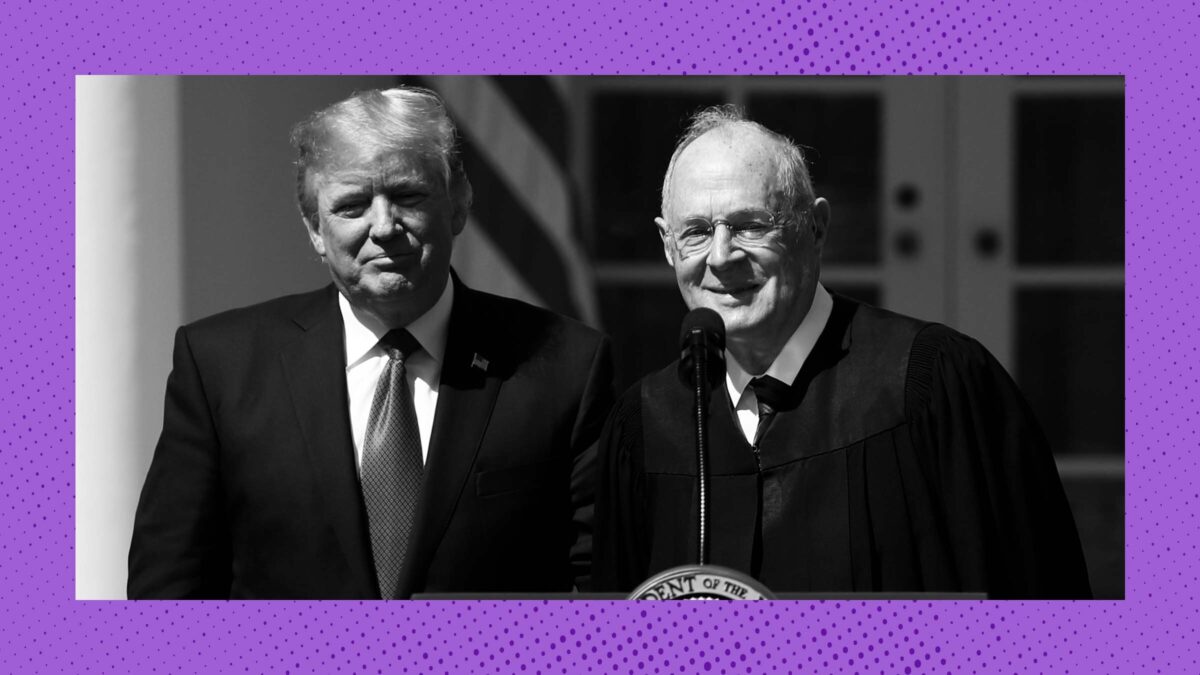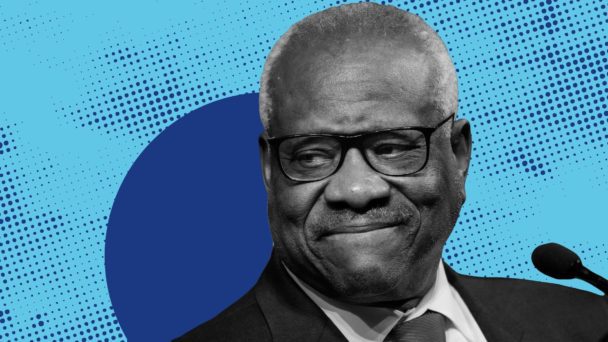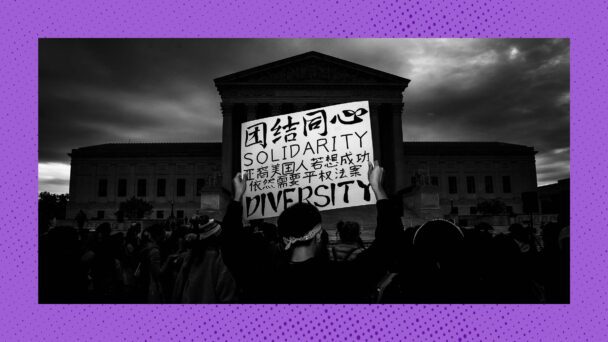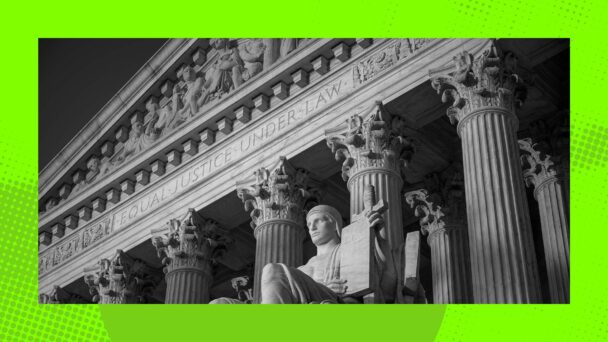If you are a Supreme Court justice attending a State of the Union address, the rules of engagement are pretty simple: Your job, no matter what the president says or does, is to sit quietly and maintain a poker face until the evening is finally, mercifully over. You do not clap for anything more controversial than “God bless America.” You do not stand up from your chair unless the fire alarm is going off and you can actually see flames licking at the ceiling. And in the receiving line afterwards, you stick to pleasant banalities, and are careful to utter the bare minimum number of words that will prompt the president to move on to someone else.
For the most part, the justices who attended President Donald Trump’s joint address to Congress understood the assignment. Justice Amy Coney Barrett offered only a demure “thank you.” Justice Brett Kavanaugh’s stilted “best to your family” was about as inoffensively all-business as it gets. Although Chief Justice John Roberts’s name appeared in unflattering headlines in the days that followed, it was Trump who did all the talking; as best I can tell, all Roberts did was dutifully shake the hand extended to him and then shuffle to the exit.
Trump’s exchange with Justice Anthony Kennedy, who retired in 2018, was different. As Trump grasped his hand, a beaming Kennedy pulled the president close. “Thank you for teaching young people to love America,” he appeared to say, with the knowing little finger point of a man who is supremely confident in the profundity of the wisdom he just imparted.
Trump responded with a stern nod and an off-the-cuff self-deprecating quip. “Well, I’m trying to,” he said, smiling and pointing back at Kennedy. “Great guy.”
Between the background noise and spotty microphone pickup, the audio quality isn’t great, which might help explain why Trump’s encounter with Kennedy received much less media attention than his encounter with Roberts. Kennedy’s first few words are particularly tough to make out; you can listen to isolated audio for yourself below.
The quoted language, though, appears to most closely match Kennedy’s cadence and the movements of his lips, and also makes the most sense in the context of Trump’s aw-shucks response. In any event, the precise sequence at the beginning of the sentence is less important than the readily apparent takeaway: Kennedy wanted to impart his appreciation for Trump’s visionary leadership, and urge him to keep up the good work. Through the Supreme Court Public Information Office, I reached out to ask Kennedy about this exchange. He did not respond to my request for comment.
Lavishing Trump with praise in a semi-public setting is unusual for any justice, and might feel especially inconsistent with Kennedy’s reputation as the Court’s swing vote—a Republican appointee who nevertheless delivered key victories for liberals on issues like abortion, same-sex marriage, and capital punishment. But the Republican Party spent Kennedy’s entire tenure lurching ever further to the right, organizing itself as a cult of personality that now exists to promote the financial interests of an elderly television personality and whichever reactionary billionaire called him most recently to ask for a favor. Kennedy’s enduring image as a moderate Republican is at odds with the inescapable reality that in recent years, every other moderate Republican has had to either abandon moderation to remain relevant in the party, or else abandon the party altogether.
The idea that Trump, who once reacted to losing a presidential election by fomenting a violent coup across the street from Kennedy’s old office, is “teaching young people to love America” is hardly unusual among Republican men of a certain age and stature. It is only notable because Kennedy, in retirement, no longer feels the need to be shy about expressing it.
Kennedy was nominated to the Court by President Ronald Reagan in 1987 to replace the retiring Justice Lewis Powell. But he was not Reagan’s first choice, and received the nod only after two other nominees failed in spectacular fashion, albeit for very different reasons. First, the Senate rejected Robert Bork, a conservative darling who once opined that a poll tax was too “small” to be constitutionally suspect, for being a far-right creep; six Republican senators joined Democrats in voting him down. Reagan then turned to federal appeals court judge Douglas Ginsburg, who quickly withdrew from consideration after reports that he’d—brace yourself—smoked weed while teaching at Harvard Law School in the 1970s proved too embarrassing for the White House to tolerate.
In the wake of this pair of circuses, Kennedy’s most important attribute was the fact that none of his attributes were especially controversial: a staid federal appeals court judge from California who moonlit as a constitutional law professor. The New York Times described him as a “restrained pragmatist,” and soon after Reagan’s announcement, Linda Greenhouse reported the “general expectation” among senators of both parties that Kennedy would sail through the process, notwithstanding the “bitter” feelings among some Republicans who still pined for a Bork-like figure instead. The Senate confirmed Kennedy three months later, 97-0, in what will probably be the last-ever unanimous Supreme Court confirmation vote.
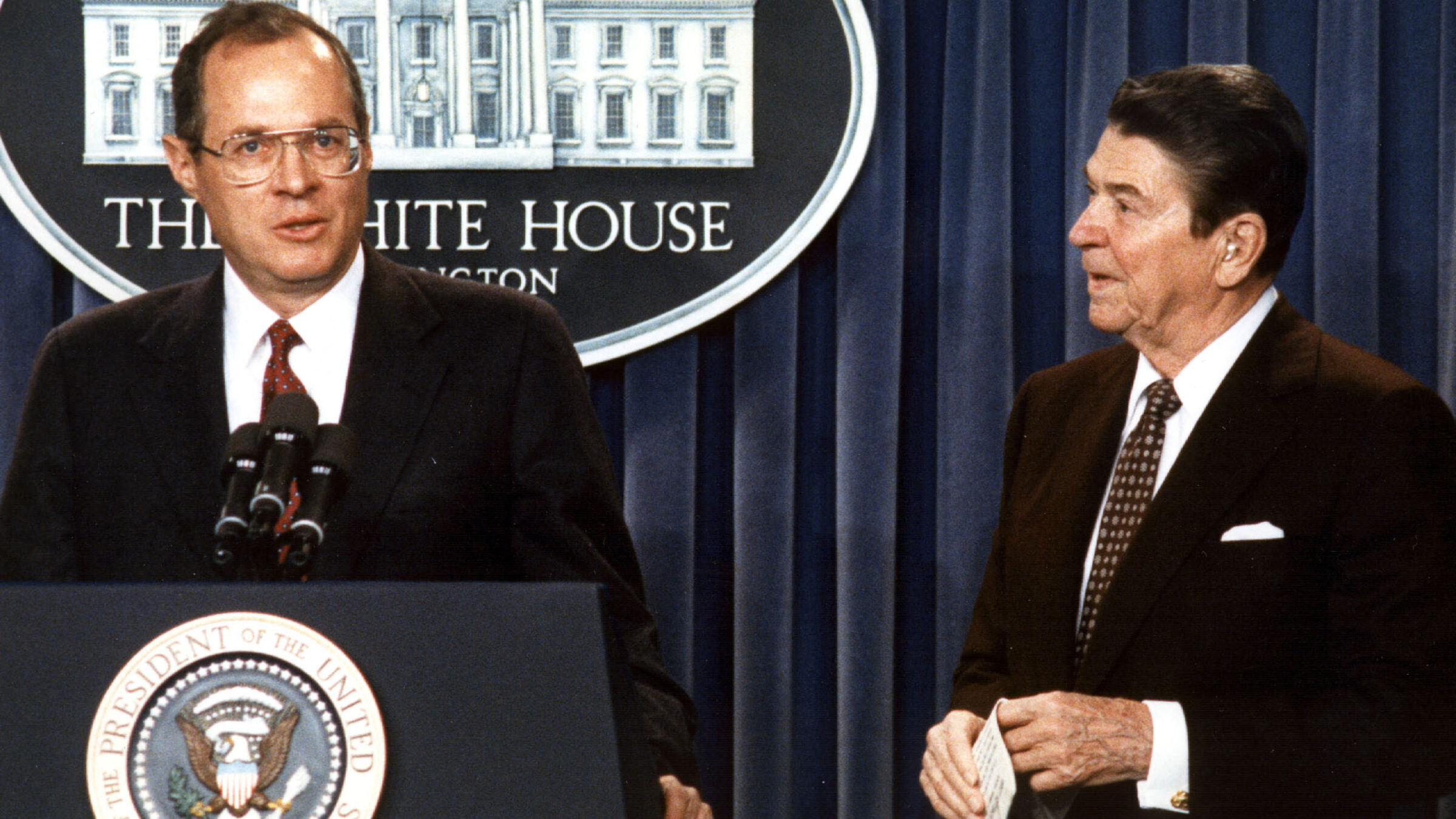
(Photo by MIKE SARGENT/AFP via Getty Images)
Sure enough, over his 30 years on the bench, some of Kennedy’s highest-profile votes sparked howling fury among reactionaries who expected more from the justice who could have been Robert Bork. Kennedy wrote for the five-justice majority in Obergefell v. Hodges, the 2015 case that established a constitutional right to marriage equality; in dissent, Justice Antonin Scalia described the outcome as a “threat to American democracy,” and said he’d sooner “hide [his] head in a bag” than sign on to Kennedy’s opinion. In 1992, Kennedy joined a plurality in Planned Parenthood v. Casey that upheld the basic structure of Roe v. Wade, a betrayal that prompted Federalist Society types to redouble their efforts to keep squishy conservatives from coming anywhere near a Supreme Court seat ever again.
(Another reason Kennedy’s colleagues found him annoying: In private, he was kind of a preening, vainglorious self-promoter who loved the attention that came with his power to tip cases one way or the other. In the hours before the Court announced its decision in Casey, a journalist profiling Kennedy described him standing in his chambers, staring down at protesters assembled on the plaza below, seemingly lost in thought. “Sometimes, you don’t know if you’re Caesar about to cross the Rubicon, or Captain Queeg cutting your own tow line,” Kennedy said. He then asked the journalist to leave, explaining that he needed time alone to “brood.”)
But in the cases that mattered most to his Republican Party, Kennedy’s loyalties were never in doubt. He joined the majorities in Shelby County v. Holder, a 2013 case that gutted the Voting Rights Act, and District of Columbia v. Heller, a 2008 case in which the conservatives rewrote the Second Amendment to say what gun lobbyists think the framers ought to have said. Kennedy’s majority opinion in Citizens United v. Federal Election Commission, in which the Court struck down key aspects of bipartisan money-in-politics legislation in 2010, paved the way for Elon Musk to spend a quarter-billion dollars to buy Trump’s election victory 14 years later. And in 2000, when the justices had to decide the outcome of a disputed presidential election, Kennedy—along with another purportedly “centrist” Republican, Justice Sandra Day O’Connor—joined the conservatives to hand the White House to George W. Bush.
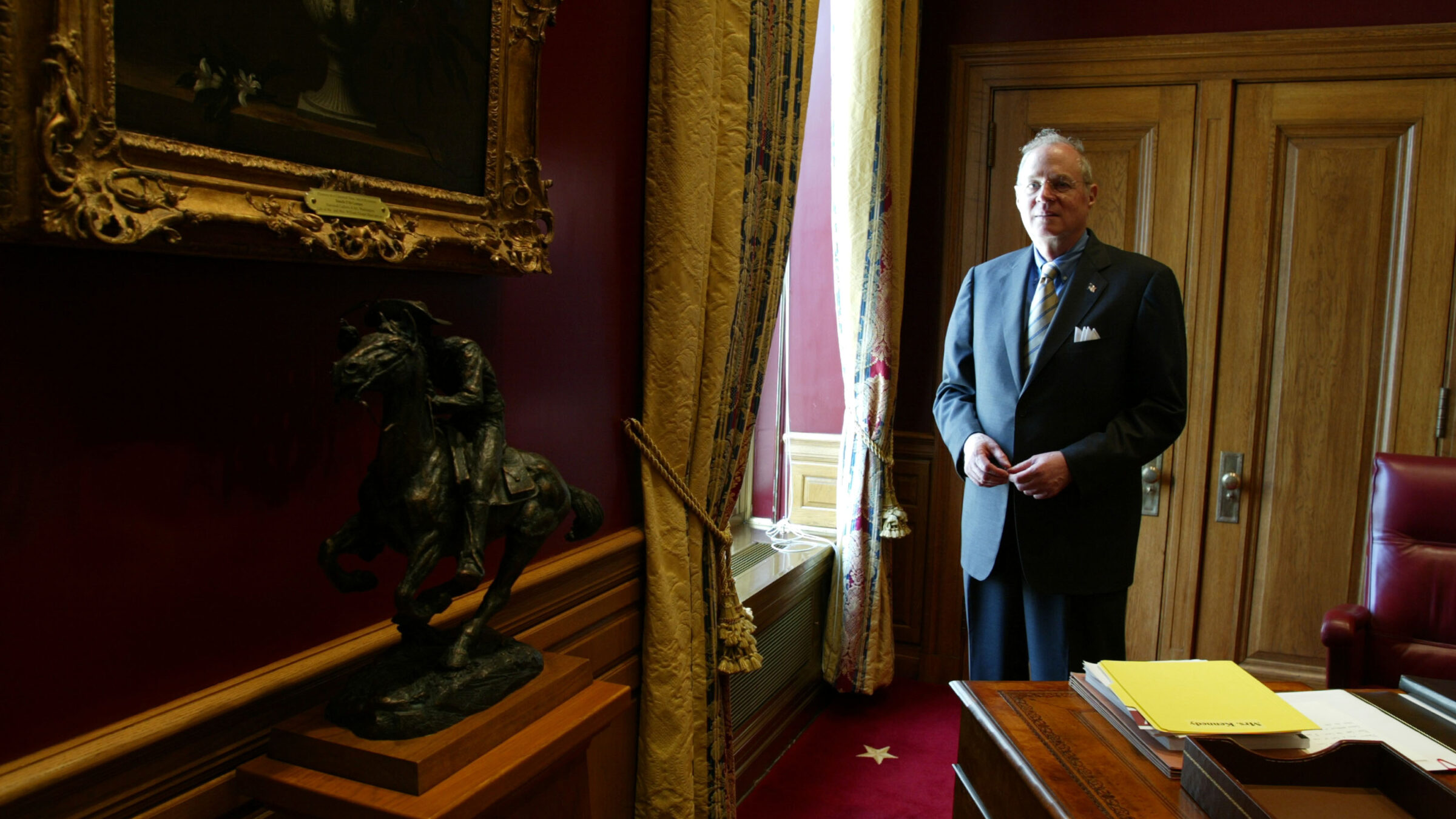
Kennedy in his chambers, 2002 (Photo by David Hume Kennerly/Getty Images)
In his later years, Kennedy’s jurisprudence became harder to distinguish from that of the other Republican appointees. In the 2017-18 term, when the Court decided 14 cases that split 5-4 along ideological lines, Kennedy voted with the conservatives in all of them. By stepping down that summer, he ensured that a Republican president and a Republican-controlled Senate had time to install his successor before the midterms. And he knew who he wanted that successor to be: In 2017, Kennedy reportedly asked Trump to put Kavanaugh, one his former clerks, on the Supreme Court shortlist, and again urged Trump to pick Kavanaugh when he privately informed the president of his retirement. If you are a justice who actually cares about preserving your legacy as a principled defender of civil liberties, stumping for a longtime Republican political operative is not the way you orchestrate your exit.
Popular conceptions of Supreme Court justices tend to be simple and static, and usually echo the narrative at the time of their appointment. To this day, many pundits still treat Roberts as the Court’s courageous institutionalist, thanks to his “judges are umpires calling balls and strikes” speech that dominated coverage of his confirmation almost 20 years ago. Similarly, the circumstances surrounding Kennedy’s nomination—Bork’s devastating flameout, Ginsburg’s humiliating withdrawal, and the Reagan White House’s desperation to get someone confirmed before they had to move on to Plan D—cemented his reputation as the Court’s earnest, humble moderate, a role he was happy to play with melodramatic flair whenever the opportunity presented itself.
Kennedy’s exchange with Trump highlights just how wrong these narratives can be. However stonefaced they manage to remain during State of the Union addresses, judges are real people with partisan loyalties that do not magically disappear the moment they take their oaths of office. As the Republican Party changed over the course of Kennedy’s career, so did he, which is how he went from writing the majority opinion in Obergefell to praising an anti-constitutional president for “teaching young people to love America” in less than a decade. Being on the Supreme Court was never going to stop Anthony Kennedy from radicalizing along with his party. It just allowed him to do so a little more quietly.
Special thanks to Rob Gunther and David New for providing technical assistance.
